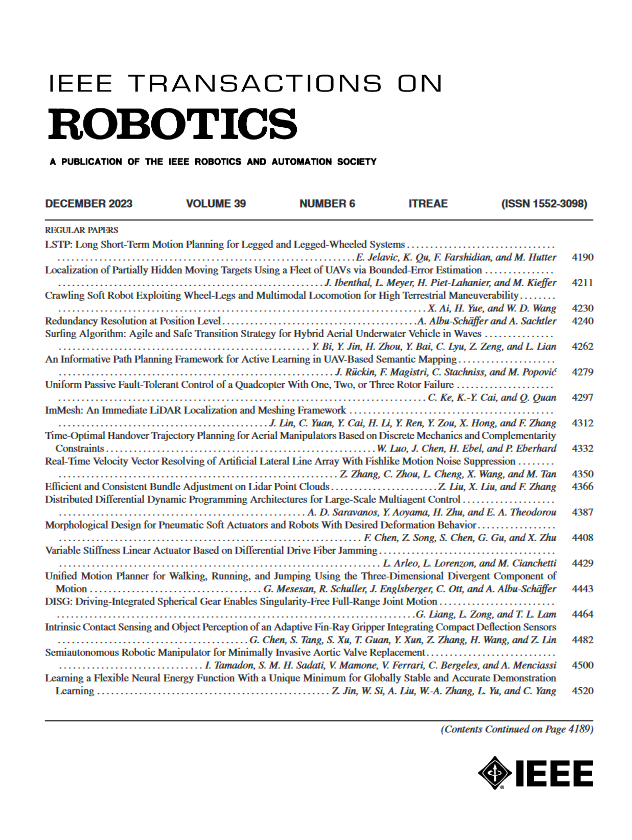Online Adaptation Framework Enables Personalization of Exoskeleton Assistance During Locomotion in Patients Affected by Stroke
IF 10.5
1区 计算机科学
Q1 ROBOTICS
引用次数: 0
Abstract
Robotic exoskeletons can transform mobility for individuals with lower limb disabilities. However, their widespread adoption is limited by controller degradation caused by varying gait dynamics across different users and environments. Here, we propose an online adaptation framework that leverages real-time data streams to continuously update the user state estimator model. This approach allows the exoskeleton to learn the user-specific gait patterns, effectively customizing the model for each new user. In addition, we demonstrate a sensor signal transformation technique that enables model transfer across different exoskeleton hardware (from a research-grade exoskeleton to a commercial device). With less than one minute of adaptation, our framework improved gait phase estimation, which directly affects assistance timing, by 40.9% for able-bodied subjects and 65.9% for stroke survivors (在线适应框架使受中风影响的患者运动期间外骨骼辅助个性化
机器人外骨骼可以改变下肢残疾人的行动能力。然而,由于不同用户和环境的步态动力学变化引起的控制器退化,限制了它们的广泛采用。在这里,我们提出了一个在线自适应框架,利用实时数据流不断更新用户状态估计器模型。这种方法允许外骨骼学习用户特定的步态模式,有效地为每个新用户定制模型。此外,我们还演示了一种传感器信号转换技术,该技术可以跨不同外骨骼硬件(从研究级外骨骼到商业设备)进行模型传输。在不到一分钟的适应时间内,我们的框架改进了直接影响辅助时间的步态相位估计,在健全受试者中提高了40.9%,在中风幸存者中提高了65.9% (p$ $< $ 0.05),与基线模型相比,扭矩轮廓误差降低了32.7% (p$ $< $ 0.05)。此外,在试点测试中,我们将我们的自适应框架与人在环优化应用于控制调谐。在一名中风幸存者中,与没有外骨骼的行走相比,这种方法使行走速度提高了21.8%,代谢成本降低了6.5%。虽然是初步的,但这些结果表明在临床人群中个性化外骨骼辅助的潜力。
本文章由计算机程序翻译,如有差异,请以英文原文为准。
求助全文
约1分钟内获得全文
求助全文
来源期刊

IEEE Transactions on Robotics
工程技术-机器人学
CiteScore
14.90
自引率
5.10%
发文量
259
审稿时长
6.0 months
期刊介绍:
The IEEE Transactions on Robotics (T-RO) is dedicated to publishing fundamental papers covering all facets of robotics, drawing on interdisciplinary approaches from computer science, control systems, electrical engineering, mathematics, mechanical engineering, and beyond. From industrial applications to service and personal assistants, surgical operations to space, underwater, and remote exploration, robots and intelligent machines play pivotal roles across various domains, including entertainment, safety, search and rescue, military applications, agriculture, and intelligent vehicles.
Special emphasis is placed on intelligent machines and systems designed for unstructured environments, where a significant portion of the environment remains unknown and beyond direct sensing or control.
 求助内容:
求助内容: 应助结果提醒方式:
应助结果提醒方式:


